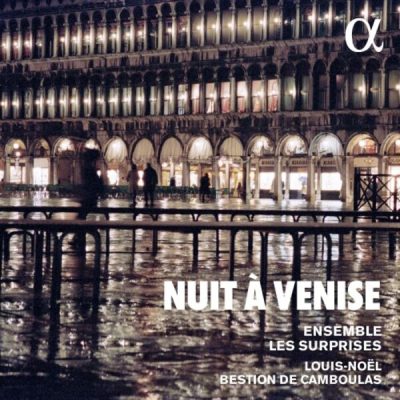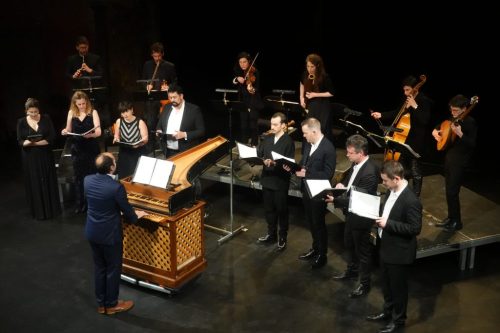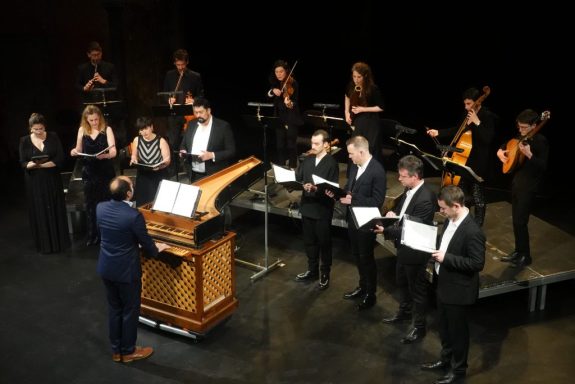 France Itinéraire Baroque en Périgord [1], 2024 – Nuit à Venise: Les Maîtres de Chapelle de San Marco: Ensemble Les Surprises / Louis-Noêl Bestion de Camboulas (organ / harpsichord). Église Abbatiale Saint-Cybard de Cercles, 1.8.2024. (CC)
France Itinéraire Baroque en Périgord [1], 2024 – Nuit à Venise: Les Maîtres de Chapelle de San Marco: Ensemble Les Surprises / Louis-Noêl Bestion de Camboulas (organ / harpsichord). Église Abbatiale Saint-Cybard de Cercles, 1.8.2024. (CC)

Giovanni Legrenzi (1625-1690) – De profundis; Adagio La Cetra; Ingemisco; Ore Supplex; Salve Regina
Tarquinio Merula (1595-1665) – Ballo detto Eccardo
Giovanni Rigatti (1613-1648) – Magnificat
Claudio Monteverdi (1567-1643) – Longe mi Jesu; Troppo ben può; Pulchræ sunt genæ tuæ; Laudate dominum primo; Dixit Domunus secondo
Alessandro Grandi (1590-1630) – O quam tu pulchra es
Antonio Lotti (1667-1740) – Crucifixus
Salomone Rossi (1570-1620) – Sinfonie et Gagliarde: Sinfonia grave; Gagliarda
Francesco Cavalli (1602-1675) – Missa Concertata: Agnus Dei
Giovanni Battista Fontana (1589-1630) – Sonata XVI
The 2024 edition of Itinéraire Baroque has an especial resonance: it celebrates the 80th birthday of its founder, Ton Koopman (2017 interview here), who has been at its head for some 23 years. 2024 brought together musicians from Spain, the Netherlands, the UK, Belgium, Switzerland, Austria, and Italy. The festival ended with an unforgettable account of Bach’s St John Passion, but the Itinéraire itself remains a real focus.
The opening event on August 1 was a concert of Venetian music based around the Masters of the Chapel of San Marco, replicating most of the recent Alpha release (also called Nuit à Venise) by Ensemble Les Surprises. The programme is a re-imagining of an evening’s celebration in the Piazza San Marco; the music is centred around pieces by Monteverdi and features music of his successors at the chapel (Cavalli, Legrenzi, Lotti), plus other musicians active in Venice at that time. There is music both sacred and profane, exploring in the process connections between the two in the music of that time (the Monteverdi sacred motets heard here, Longe mi Jesu and Pulchræ sunt genæ tuæ were originally secular motets, for example).
The evening began with music by Giovanni Legrenzi, his De profundis (‘Out of the depths I cried to Thee, O Lord’) from that composer’s Sacri e Festivi Concerti, Op.9, first published in 1667. The antiphonal distribution of the performers was most effective: SATB – organ – BTAS (one female alto, the other male). The whole was shot through with life, leading to an exceptionally bright toned ‘Gloria Patri, et Filio, et Spirito Sancto’ (‘Glory to the Father, to the Son, and to the Holy Spirit’).
The contrast of instrumental and vocal was vital in this concert was a vital part of the equation. Cue Tarquinio Merulo’s Ballo detto Eccardo, the 23rd piece from Canzoni overo Sonate concertate per chiesa e camera, 2 or 3 instruments, Book 3, Op.12 (1637). This piece is as bright as a button, recorders (Sarah Dubus and Anaïs Ramage) as sprightly as can be, a moment in the spotlight with just theorbo (Gabriel Rignol) utter delight.
A Magnificat by Giovanni Antonio Rigatti offered huge contrast: from the a-leaping and bounding Merula to the slow, ceremonial tread of Rigatti. Scored for voices and seven instruments, it was published in 1640 and here received a performance of commanding majesty. When counterpoint unfolds, it was miraculous (around ‘anima mea’, and then later, in a more joyous outbreak, at ‘fecit potentiam’). The drooping lines at ‘Suscepit Isreal’ were like drops of rain sliding down a window. Truly memorable. The piece’s sudden changes in mood were expertly tracked by Les Surprises.
From his fourth book of sonatas, Legrenzi’s infinitely touching La Cetra, an adagio replete with exquisite suspensions. The instrumental textures were remarkable; as they were, reciprocally, in the choral and instrumental Longe mi Jesu (from Monteverdi’s Seventh Book of Madrigals). To hear them juxtaposed in this fashion in performances of such quality was a privilege indeed.
Alessandro Grandi was both friend to Monteverdi and also deputised for the great man at the Capella Marciano at San Marco (he later became maestro di cappella at Bergamo). His motet, O quam tu pulchra es, is for three male voices and basso continuo, taken from the multi-composer publication Ghirlanda sacra (Venice, 1625). Sung from the back of the church and therefore floating over the audience, this was a moment of great intimacy. It culminated in the purest of octaves.

Instrumental pieces were far more than interludes: Monteverdi’s Troppo ben può was superb in its exchanges before the ever-so-tender vocal Pulchræ sunt genæ tuæ. The meeting of vocal and instrumental in Monteverdi’s Laudate Dominum primo was perfect (some extraordinarily imagined descents here, realised with a real sense of modernity by Les Surprises).
Time and time again placing Legrenzi in amongst this company of composers only proved his greatness. The Ingemisco (‘I groan as one who is guilty;) and Oro Supplex (‘I pray, kneeling in supplication’) are both from the motet Prosa pro moruis (Dies Irae) and speak of true greatness. The Ingemisco can only be described as a sort of glorious darkness, the high male lines of Oro Supplex speak of a heart-rending placing of one’s fate in the hands of the Christian god. The purity of the intervals in performance of these remarkable pieces contributed markedly to the performance’s success.
Of all pieces on the programme, perhaps Lotti’s eight-voice Crucifixus was the most famous. Few performances though contained the power of this, due in no small part to the ensemble’s accuracy of pitch. Lotti’s harmonies are in no way predicable, with some harmonic twists of the knife that cut to the quick.
From Salomone Rossi’s first book of Sinfonie et Gagliarde, first published 1607, came the Sinfonia grave and Gagliarda, moments of dignified repose, superbly polished, But they could hardly prepare for the glorious interiorisations of the Agnus Dei from Cavalli’s Missa Concertata, first published within Musica Sacre, 1656. Antiphony worked beautifully, the two vocal groups on either side of the church with the organ centre-stage.
A beautifully articulated Sonata XVI by Giovanni Mattista Fontana was a lovely but short glimpse of beauty prior to Legrenzi’s stunning Salve Regina, the repeated pleas contrasting beautifully with the Dixit Dominus secondo (which actually opens the Alpha disc).
An incredible way to officially open the 2024 Itinéraire Baroque (previous reviews of this festival can be found if you click here).
Colin Clarke
